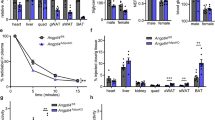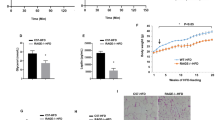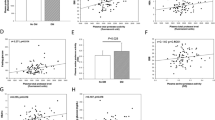Abstract
Obesity is the central promoter of the metabolic syndrome which also includes disturbed fibrinolysis in addition to hypertension, dyslipidaemia and impaired glucose tolerance/type 2 diabetes mellitus. Plasminogen activator inhibitor-1 (PAI-1) is the most important endogenous inhibitor of tissue plasminogen activator and uro-plasminogen activator, and is a main determinant of fibrinolytic activity. There is now compelling evidence that obesity and, in particular, an abdominal type of body fat distribution are associated with elevated PAI-1 antigen and activity levels. Recent studies established that PAI-1 is expressed in adipose tissue. The greater the fat cell size and the adipose tissue mass, the greater is the contribution of adipose production to circulating PAI-1. Experimental data show that visceral adipose tissue has a higher capacity to produce PAI-1 than subcutaneous adipose tissue. Studies in human adipocytes indicate that PAI-1 synthesis is upregulated by insulin, glucocorticoids, angiotensin II, some fatty acids and, most potently, by cytokines such as tumour necrosis factor-α and transforming growth factor-β, whereas catecholamines reduce PAI-1 production. Interestingly, pharmacological agents such as thiazolidinediones, metformin and AT1-receptor antagonists were found to reduce adipose expression of PAI-1. In addition, weight loss by dietary restriction or comprehensive lifestyle modification is effective in lowering PAI-1 plasma levels. In conclusion, impaired fibrinolysis in obesity is probably also due to an increased expression of PAI-1 in adipose tissue. An altered function of the endocrine system and an impaired auto-/paracrine function at the fat cell levels may mediate this disturbance of the fibrinolytic system and thereby increase the risk for cardiovascular disease.
This is a preview of subscription content, access via your institution
Access options
Subscribe to this journal
Receive 12 print issues and online access
$259.00 per year
only $21.58 per issue
Buy this article
- Purchase on Springer Link
- Instant access to full article PDF
Prices may be subject to local taxes which are calculated during checkout



Similar content being viewed by others
References
World Health Organization. Obesity: preventing and managing the global epidemic. WHO Technical Report Series, Geneva 894; 2000.
Reaven GM . Role of insulin resistance in human disease (syndrome X): an expanded definition. Annu Rev Med 1993; 44: 121–131.
Isomaa B, Almgren P, Tuomi T, Forsen B, Lahti K, Nissen M, Taskinen MR, Groop L . Cardiovascular morbidity and mortality associated with the metabolic syndrome. Diabetes Care 2001; 24: 683–689.
Lakka HM, Laaksonen DE, Lakka TA, Niskanen LK, Kumpusalo E, Tuomilehto J, Salonen JT . The metabolic syndrome and total and cardiovascular disease mortality in middle-aged men. JAMA 2002; 288: 2709–2716.
Hamsten A, de Faire U, Walldius G, Dahlen G, Szamosi A, Landou C, Blomback M, Wiman B . Plasminogen activator inhibitor in plasma: risk factor for recurrent myocardial infarction. Lancet 1987; 2: 3–9.
Juhan-Vague I, Pyke SD, Alessi MC, Jespersen J, Haverkate F, Thompson SG . Fibrinolytic factors and the risk of myocardial infarction or sudden death in patients with angina pectoris. ECAT Study Group. European Concerted Action on Thrombosis and Disabilities. Circulation 1996; 94: 2057–2063.
Thompson SG, Kienast J, Pyke SD, Haverkate F, van de Loo JC . Hemostatic factors and the risk of myocardial infarction or sudden death in patients with angina pectoris. European Concerted Action on Thrombosis and Disabilities Angina Pectoris Study Group. N Engl J Med 1995; 332: 635–641.
Loskutoff DJ, Samad F . The adipocyte and hemostatic balance in obesity: studies of PAI-1. Arterioscler Thromb Vasc Biol 1998; 18: 1–6.
Kohler HP, Grant PJ . Plasminogen-activator inhibitor type 1 and coronary artery disease. N Engl J Med 2000; 342: 1792–1801.
Juhan-Vague I, Vague P, Alessi MC, Badier C, Valadier J, Aillaud MF, Atlan C . Relationships between plasma insulin triglyceride, body mass index, and plasminogen activator inhibitor 1. Diab Metab 1987; 13: 331–336.
Landin K, Stigendal L, Eriksson E, Krotkiewski M, Risberg B, Tengborn L, Smith U . Abdominal obesity is associated with an impaired fibrinolytic activity and elevated plasminogen activator inhibitor-1. Metabolism 1990; 39: 1044–1048.
Potter van Loon BJ, Kluft C, Radder JK, Blankenstein MA, Meinders AE . The cardiovascular risk factor plasminogen activator inhibitor type 1 is related to insulin resistance. Metabolism 1993; 42: 945–949.
McGill JB, Schneider DJ, Arfken CL, Lucore CL, Sobel BE . Factors responsible for impaired fibrinolysis in obese subjects and NIDDM patients. Diabetes 1994; 43: 104–109.
Giltay EJ, Elbers JM, Gooren LJ, Emeis JJ, Kooistra T, Asscheman H, Stehouwer CD . Visceral fat accumulation is an important determinant of PAI-1 levels in young, nonobese men and women: modulation by cross-sex hormone administration. Arterioscler Thromb Vasc Biol 1998; 18: 1716–1722.
Janand-Delenne B, Chagnaud C, Raccah D, Alessi MC, Juhan-Vague I, Vague P . Visceral fat as a main determinant of plasminogen activator inhibitor 1 level in women. Int J Obes Relat Metab Disord 1998; 22: 312–317.
Skurk T, Lee YM, Nicuta-Rolfs TO, Haastert B, Wirth A, Hauner H . Effect of the angiotensin II receptor blocker candesartan on fibrinolysis in patients with mild hypertension. Diabetes Obes Metab 2004; 6: 56–62.
Sawdey MS, Loskutoff DJ . Regulation of murine type 1 plasminogen activator inhibitor gene expression in vivo. Tissue specificity and induction by lipopolysaccharide, tumor necrosis factor-alpha, and transforming growth factor-beta. J Clin Invest 1991; 88: 1346–1353.
Samad F, Yamamoto K, Loskutoff DJ . Distribution and regulation of plasminogen activator inhibitor-1 in murine adipose tissue in vivo. Induction by tumor necrosis factor-alpha and lipopolysaccharide. J Clin Invest 1996; 97: 37–46.
Samad F, Uysal KT, Wiesbrock SM, Pandey M, Hotamisligil GS, Loskutoff DJ . Tumor necrosis factor alpha is a key component in the obesity-linked elevation of plasminogen activator inhibitor 1. Proc Natl Acad Sci USA 1999; 96: 6902–6907.
Alessi MC, Peiretti F, Morange P, Henry M, Nalbone G, Juhan-Vague I . Production of plasminogen activator inhibitor 1 by human adipose tissue: possible link between visceral fat accumulation and vascular disease. Diabetes 1997; 46: 860–867.
Eriksson P, Reynisdottir S, Lonnqvist F, Stemme V, Hamsten A, Arner P . Adipose tissue secretion of plasminogen activator inhibitor-1 in non-obese and obese individuals. Diabetologia 1998; 41: 65–71.
Cigolini M, Tonoli M, Borgato L, Frigotto L, Manzato F, Zeminian S, Cardinale C, Camin M, Chiaramonte E, De Sandre G, Lunardi C . Expression of plasminogen activator inhibitor-1 in human adipose tissue: a role for TNF-alpha? Atherosclerosis 1999; 143: 81–90.
Crandall DL, Quinet EM, Morgan GA, Busler DE, McHendry-Rinde B, Kral JG . Synthesis and secretion of plasminogen activator inhibitor-1 by human preadipocytes. J Clin Endocrinol Metab 1999; 84: 3222–3227.
Gottschling-Zeller H, Birgel M, Rohrig K, Hauner H . Effect of tumor necrosis factor alpha and transforming growth factor beta 1 on plasminogen activator inhibitor-1 secretion from subcutaneous and omental human fat cells in suspension culture. Metabolism 2000; 49: 666–671.
Yudkin JS, Coppack SW, Bulmer K, Rawesh A, Mohamed-Ali V . Lack of evidence for secretion of plasminogen activator inhibitor-1 by human subcutaneous adipose tissue in vivo. Thromb Res 1999; 96: 1–9.
Morange PE, Alessi MC, Verdier M, Casanova D, Magalon G, Juhan-Vague I . PAI-1 produced ex vivo by human adipose tissue is relevant to PAI-1 blood level. Arterioscler Thromb Vasc Biol 1999; 19: 1361–1365.
Shimomura I, Funahashi T, Takahashi M, Maeda K, Kotani K, Nakamura T, Yamashita S, Miura M, Fukuda Y, Takemura K, Tokunaga K, Matsuzawa Y . Enhanced expression of PAI-1 in visceral fat: possible contributor to vascular disease in obesity. Nat Med 1996; 2: 800–803.
Halleux CM, Declerck PJ, Tran SL, Detry R, Brichard SM . Hormonal control of plasminogen activator inhibitor-1 gene expression and production in human adipose tissue: stimulation by glucocorticoids and inhibition by catecholamines. J Clin Endocrinol Metab 1999; 84: 4097–4105.
Eriksson P, van Harmelen V, Hoffstedt J, Lundquist P, Vidal H, Stemme V, Hamsten A, Arner P, Reynisdottir S . Regional variation in plasminogen activator inhibitor-1 expression in adipose tissue from obese individuals. Thromb Haemost 2000; 83: 545–548.
Mavri A, Alessi MC, Bastelica D, Geel-Georgelin O, Fina F, Sentocnik JT, Stegnar M, Juhan-Vague I . Subcutaneous abdominal, but not femoral fat expression of plasminogen activator inhibitor-1 (PAI-1) is related to plasma PAI-1 levels and insulin resistance and decreases after weight loss. Diabetologia 2001; 44: 2025–2031.
Bastelica D, Morange P, Berthet B, Borghi H, Lacroix O, Grino M, Juhan-Vague I, Alessi MC . Stromal cells are the main plasminogen activator inhibitor-1-producing cells in human fat: evidence of differences between visceral and subcutaneous deposits. Arterioscler Thromb Vasc Biol 2002; 22: 173–178.
Bastelica D, Mavri A, Verdierl M, Berthet B, Juhan-Vague I, Alessi MC . Relationships between fibrinolytic and inflammatory parameters in human adipose tissue: strong contribution of TNFalpha receptors to PAI-1 levels. Thromb Haemost 2002; 88: 481–487.
Birgel M, Gottschling-Zeller H, Röhrig K, Hauner H . Role of cytokines in the regulation of plasminogen activator inhibitor-1 expression and secretion in newly differentiated subcutaneous human adipocytes. Arterioscler Thromb Vasc Biol 2000; 20: 1682–1687.
Gesta S, Lolmede K, Daviaud D, Berlan M, Bouloumie A, Lafontan M, Valet P, Saulnier-Blache JS . Culture of human adipose tissue explants leads to profound alteration of adipocyte gene expression. Horm Metab Res 2003; 35: 158–163.
Hube F, Hauner H . The role of TNF-alpha in human adipose tissue: prevention of weight gain at the expense of insulin resistance? Horm Metab Res 1999; 31: 626–631.
Alessi MC, Bastelica D, Morange P, Berthet B, Leduc I, Verdier M, Geel O, Juhan-Vague I . Plasminogen activator inhibitor 1, transforming growth factor-beta1, and BMI are closely associated in human adipose tissue during morbid obesity. Diabetes 2000; 49: 1374–1380.
van Harmelen V, Ariapart P, Hoffstedt J, Lundkvist I, Bringman S, Arner P . Increased adipose angiotensinogen gene expression in human obesity. Obes Res 2000; 8: 337–341.
van Harmelen V, Elizalde M, Ariapart P, Bergstedt-Lindqvist S, Reynisdottir S, Hoffstedt J, Lundkvist I, Bringman S, Arner P . The association of human adipose angiotensinogen gene expression with abdominal fat distribution in obesity. Int J Obes Relat Metab Disord 2000; 24: 673–678.
Skurk T, Lee YM, Hauner H . Angiotensin II and its metabolites stimulate PAI-1 protein release from human adipocytes in primary culture. Hypertension 2001; 37: 1336–1340.
Schneider DJ, Sobel BE . Augmentation of synthesis of plasminogen activator inhibitor type 1 by insulin and insulin-like growth factor type I: implications for vascular disease in hyperinsulinemic states. Proc Natl Acad Sci USA 1991; 88: 9959–9963.
Banfi C, Mussoni L, Ris P, Cattaneo MG, Vicentini L, Battaini F, Galli C, Tremoli E . Very low density lipoprotein-mediated signal transduction and plasminogen activator inhibitor type 1 in cultured HepG2 cells. Circ Res 1999; 85: 208–217.
Mohamed-Ali V, Pinkney JH, Panahloo A, Cwyfan-Hughes S, Holly JM, Yudkin JS . Insulin-like growth factor binding protein-1 in NIDDM: relationship with the insulin resistance syndrome. Clin Endocrinol 1999; 50: 221–228.
Patrassi GM, Sartori MT, Rigotti P, Di Landro D, Theodoridis P, Fioretti M, Capalbo M, Saggiorato G, Boeri G, Girolami A . Reduced fibrinolytic potential one year after kidney transplantation. Relationship to long-term steroid treatment. Transplantation 1995; 59: 1416–1420.
Patrassi GM, Sartori MT, Livi U, Casonato A, Danesin C, Vettore S, Girolami A . Impairment of fibrinolytic potential in long-term steroid treatment after heart transplantation. Transplantation 1997; 64: 1610–1614.
Patrassi GM, Sartori MT, Viero ML, Scarano L, Boscaro M, Girolami A . The fibrinolytic potential in patients with Cushing's disease: a clue to their hypercoagulable state. Blood Coagul Fibrinolysis 1992; 3: 789–793.
van Zonneveld AJ, Curriden SA, Loskutoff DJ . Type 1 plasminogen activator inhibitor gene: functional analysis and glucocorticoid regulation of its promoter. Proc Natl Acad Sci USA 1988; 85: 5525–5529.
Bujalska IJ, Walker EA, Tomlinson JW, Hewison M, Stewart PM . 11Beta-hydroxysteroid dehydrogenase type 1 in differentiating omental human preadipocytes: from de-activation to generation of cortisol. Endocr Res 2002; 28: 449–461.
Gottschling-Zeller H, Aprath I, Skurk T, Hauner H . Beta-Adrenoceptor agonists and other cAMP elevating agents suppress PAI-1 production of human adipocytes in primary culture. Horm Metab Res 2000; 32: 509–514.
Chen YQ, Su M, Walia RR, Hao Q, Covington JW, Vaughan DE . Sp1 sites mediate activation of the plasminogen activator inhibitor-1 promoter by glucose in vascular smooth muscle cells. J Biol Chem 1998; 273: 8225–8231.
Chautan M, Latron Y, Anfosso F, Alessi MC, Lafont H, Juhan-Vague I, Nalbone G . Phosphatidylinositol turnover during stimulation of plasminogen activator inhibitor-1 secretion induced by oxidized low density lipoproteins in human endothelial cells. J Lipid Res 1993; 34: 101–110.
Calles-Escandon J, Mirza SA, Sobel BE, Schneider DJ . Induction of hyperinsulinemia combined with hyperglycemia and hypertriglyceridemia increases plasminogen activator inhibitor 1 in blood in normal human subjects. Diabetes 1998; 47: 290–293.
Uchida Y, Ohba KI, Yoshioka T, Irie K, Muraki T, Maru Y . Cellular carbonyl stress enhances the expression of plasminogen activator inhibitor-1 in rat white adipocytes via reactive oxygen species-dependent pathway. J Biol Chem 2003; 279: 4075–4083.
Mertens I, Van Gaal LF . Obesity, haemostasis and the fibrinolytic system. Obes Rev 2002; 3: 85–101.
Sudi KM, Gallistl S, Trobinger M, Payerl D, Weinhandl G, Muntean W, Aigner R, Borkenstein MH . The influence of weight loss on fibrinolytic and metabolic parameters in obese children and adolescents. J Pediatr Endocrinol Metab 2001; 14: 85–94.
Estelles A, Dalmau J, Falco C, Berbel O, Castello R, Espana F, Aznar J . Plasma PAI-1 levels in obese children—effect of weight loss and influence of PAI-1 promoter 4G/5G genotype. Thromb Haemost 2001; 86: 647–652.
Rissanen P, Vahtera E, Krusius T, Uusitupa M, Rissanen A . Weight change and blood coagulability and fibrinolysis in healthy obese women. Int J Obes Relat Metab Disord 2001; 25: 212–218.
Lindahl B, Nilsson TK, Jansson JH, Asplund K, Hallmans G . Improved fibrinolysis by intense lifestyle intervention. A randomized trial in subjects with impaired glucose tolerance. J Intern Med 1999; 246: 105–112.
Prisco D, Paniccia R, Bandinelli B, Fedi S, Cellai AP, Liotta AA, Gatteschi L, Giusti B, Colella A, Abbate R, Gensini GF . Evaluation of clotting and fibrinolytic activation after protracted physical exercise. Thromb Res 1998; 89: 73–78.
Gardner AW, Killewich LA . Association between physical activity and endogenous fibrinolysis in peripheral arterial disease: a cross-sectional study. Angiology 2002; 53: 367–374.
Estelles A, Aznar J, Tormo G, Sapena P, Tormo V, Espana F . Influence of a rehabilitation sports programme on the fibrinolytic activity of patients after myocardial infarction. Thromb Res 1989; 55: 203–212.
Bastard JP, Vidal H, Jardel C, Bruckert E, Robin D, Vallier P, Blondy P, Turpin G, Forest C, Hainque B . Subcutaneous adipose tissue expression of plasminogen activator inhibitor-1 gene during very low calorie diet in obese subjects. Int J Obes Relat Metab Disord 2000; 24: 70–74.
Fonseca VA, Reynolds T, Hemphill D, Randolph C, Wall J, Valiquet TR, Graveline J, Fink LM . Effect of troglitazone on fibrinolysis and activated coagulation in patients with non-insulin-dependent diabetes mellitus. J Diabetes Complications 1998; 12: 181–186.
Kruszynska YT, Yu JG, Olefsky JM, Sobel BE . Effects of troglitazone on blood concentrations of plasminogen activator inhibitor 1 in patients with type 2 diabetes and in lean and obese normal subjects. Diabetes 2000; 49: 633–639.
Gottschling-Zeller H, Rohrig K, Hauner H . Troglitazone reduces plasminogen activator inhibitor-1 expression and secretion in cultured human adipocytes. Diabetologia 2000; 43: 377–383.
He G, Pedersen SB, Bruun JM, Lihn AS, Richelsen B . Metformin, but not thiazolidinediones, inhibits plasminogen activator inhibitor-1 production in human adipose tissue in vitro. Horm Metab Res 2003; 35: 18–23.
Nordt TK, Peter K, Bode C, Sobel BE . Differential regulation by troglitazone of plasminogen activator inhibitor type 1 in human hepatic and vascular cells. J Clin Endocrinol Metab 2000; 85: 1563–1568.
Kato K, Satoh H, Endo Y, Yamada D, Midorikawa S, Sato W, Mizuno K, Fujita T, Tsukamoto K, Watanabe T . Thiazolidinediones down-regulate plasminogen activator inhibitor type 1 expression in human vascular endothelial cells: a possible role for PPARgamma in endothelial function. Biochem Biophys Res Commun 1999; 258: 431–435.
Charles MA, Morange P, Eschwege E, Andre P, Vague P, Juhan-Vague I . Effect of weight change and metformin on fibrinolysis and the von Willebrand factor in obese nondiabetic subjects: the BIGPRO1 Study. Biguanides and the Prevention of the Risk of Obesity. Diabetes Care 1998; 21: 1967–1972.
Nordt TK, Kornas K, Peter K, Fujii S, Sobel BE, Kubler W, Bode C . Attenuation by gemfibrozil of expression of plasminogen activator inhibitor type 1 induced by insulin and its precursors. Circulation 1997; 95: 677–683.
Seljeflot I, Moan A, Kjeldsen S, Sandvik E, Arnesen H . Effect of angiotensin II receptor blockade on fibrinolysis during acute hyperinsulinemia in patients with essential hypertension. Hypertension 1996; 27: 1299–1304.
Erdem Y, Usalan C, Haznedaroglu IC, Altun B, Arici M, Yasavul U, Turgan C, Caglar S . Effects of angiotensin converting enzyme and angiotensin II receptor inhibition on impaired fibrinolysis in systemic hypertension. Am J Hypertens 1999; 12: 1071–1076.
Stefansson S, McMahon GA, Petitclerc E, Lawrence DA . Plasminogen activator inhibitor-1 in tumor growth, angiogenesis and vascular remodeling. Curr Pharm Des 2003; 9: 1545–1564.
Crandall DL, Busler DE, McHendry-Rinde B, Groeling TM, Kral JG . Autocrine regulation of human preadipocyte migration by plasminogen activator inhibitor-1. J Clin Endocrinol Metab 2000; 85: 2609–2614.
Author information
Authors and Affiliations
Corresponding author
Rights and permissions
About this article
Cite this article
Skurk, T., Hauner, H. Obesity and impaired fibrinolysis: role of adipose production of plasminogen activator inhibitor-1. Int J Obes 28, 1357–1364 (2004). https://doi.org/10.1038/sj.ijo.0802778
Received:
Revised:
Accepted:
Published:
Issue Date:
DOI: https://doi.org/10.1038/sj.ijo.0802778
Keywords
This article is cited by
-
miR-375 is cold exposure sensitive and drives thermogenesis in visceral adipose tissue derived stem cells
Scientific Reports (2022)
-
Intra-abdominal adipose depot variation in adipogenesis, lipogenesis, angiogenesis, and fibrosis gene expression and relationships with insulin resistance and inflammation in premenopausal women with severe obesity
Journal of Physiology and Biochemistry (2022)
-
The Adhesive Perinephric Fat Score is Correlated with Outcomes of Retroperitoneal Laparoscopic Adrenalectomy for Benign Diseases
World Journal of Surgery (2022)
-
Prenylcysteine oxidase 1, an emerging player in atherosclerosis
Communications Biology (2021)
-
Early Effects of Laparoscopic Sleeve Gastrectomy and Laparoscopic One-Anastomosis Gastric Bypass on Portal Venous Flow: a Prospective Cohort Study
Obesity Surgery (2021)



